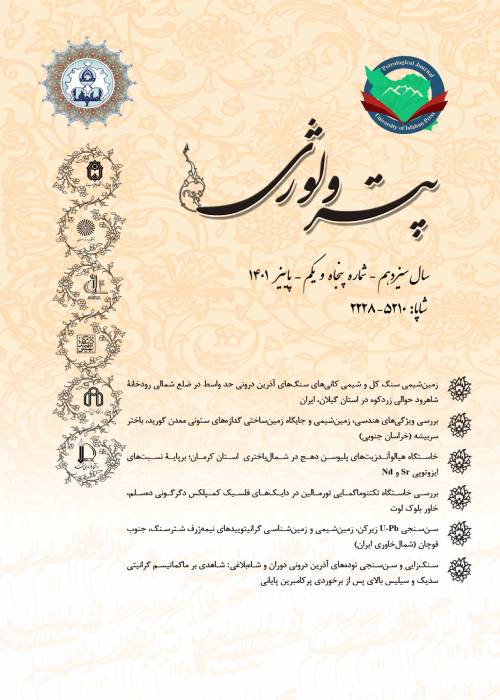Petrogenesis of fertile Skarns related to Songhor granitoid complex (North of Sanandaj- Sirjan Zone, Iran)
Magmatic fluids released at the end of magmatic crystallization interact with carbonate country rocks through metasomatism and form the skarns (Meinert et al., 2005). In general, the magmatic rocks are associated with skarnization range from diorite-gabbro to granite in composition (Kuşcu et al., 2019). The ore deposits types (e.g., Cu, Au, Fe, Zn) are controlled by the nature of the magmatic source region (Wu et al., 2017). In this study, we first synthesized the spatial distribution, and geological and geochemical data of Late Mesozoic (Middle Jurassic–Early Cretaceous) granitoids and associated mineral deposits of Songhor plutonic in the northwest of Sanandaj-Sirjan zone and compared with worldwide skarn associated granitoids. Finally we try to reach a better understanding evolution of granitoid and correlations between skarns and the related mineralization of the Songhor plutonic assembleg during Late Mesozoic.
Redgional geology:
The Galali Fe deposit is typical of skarn deposits in the Sanandaj-Sirjan metallogenic zone (SSZ), in the northeast Songhor. Mineralization in the Galali deposit is related to Songhor intrusive rocks assembleg (Eocene-Oligocene) and orebodies are predominantly hosted by Songhor Formation (Triassic-Jurassic). Petrography and geochemistry of Songhor granitoid complex (SGC) intrusive rocks have been investigated by some workers (i.e. Aliani, 2014).
Major oxides were determined using an X-ray fluorescence spectrometer, whereas the trace and rare-earth elements were analyzed by Inductively Coupled Plasma Atomic Emission Spectrometry (ICP-AES) at Zarazma laboratory company, Tehran Iran.Petrography, mineral chemistry, whole rock chemistry Based on mineralogy and geochemistry, three main facies have been recognized in the Songhor plutonic assemblage: (1) the granite (leucocratic), (2) monzonite to diorite (mesocratics) and (3) gabbro. In the Galali district both calcic exoskarn and endoskarn occur along the contacts between granitoid and host carbonated rocks. The field observations and the whole rock geochemical data obtained from the intrusive rocks in the northeast of Sonqor indicate the relationship between the region's deposits (Iron Skarn) and their tectonic and petrogenic nature.In general, Songhor granitoid complex mineralogically contain Ca-plagioclase and magnesio-hornblende, and it has a metaluminous (ASI < 1) composition, with LREE, LILE enrichment and HREE depletion. The SGC samples can be divided into two groups, based on their SiO2 contents, Na2O/K2O ratios, and incompatible elements compositions. The samples have a relatively wide range of SiO2 content and Mg# values, indicating that these units formed from magmas with variable amounts of fractional crystallization. In the Harker diagrams, there is a negative correlation between SiO2 and FeO, MgO, and CaO. Thus, these rocks record the hornblende and biotite fractionation. Similar to studies of Wu et al. (2017), the strong depletion in Ba, Sr, Eu, and Ti points to an extensive fractional crystallization during the emplacement.
Fractional crystallization would significantly increase the concentrations of W or the other incompatible elements in the magmas, which is necessary for the occurrence of related mineralization (Romer and Kroner, 2016). The results of this research indicate that the Songhor A-type alkali granite formed from the depleted mantle-derived magmas which have undergone assimilation and fractional crystallization processes. The progression from I-type to A-type magmatism appears to mark a significant change from a collisional to an extensional setting in this region, in the Late Jurassic. Geochemical characteristics in Rb versus Sc and Rb/Sr versus Zr diagrams show that mesocratic phase 1 unit, highly-oxidized and less-evolved granitoids generated by a mixture of mantle-derived and mature crust-derived components, related to subduction of Neo-Tethyan oceanic crust beneath the Sanandaj-Sirjan zone. These intrusions are syn-collisional and have a high potential for skarn Fe- Cu-Au deposits.The A-type leucocratic granite shows an alkaline nature, high potassium, high ratio Ga/Al, enrichment of HFSE (i.e. Ta, Nb, Ga, Zr, and Pb), Eu, and compatible elements (i.e. Cr) depletion in the pattern. It has formed in a magmatic arc or post-collisional setting from a hybrid source, with crustal and mantle components, contaminated by interaction with the upper crust. It is a highly-evolved granitoid that can be highly prospective for Mo, Sn, and W mineralization.
- حق عضویت دریافتی صرف حمایت از نشریات عضو و نگهداری، تکمیل و توسعه مگیران میشود.
- پرداخت حق اشتراک و دانلود مقالات اجازه بازنشر آن در سایر رسانههای چاپی و دیجیتال را به کاربر نمیدهد.



